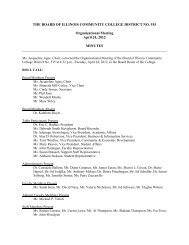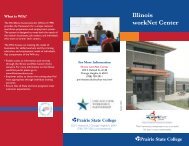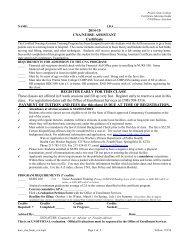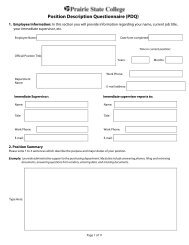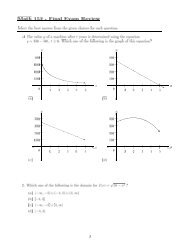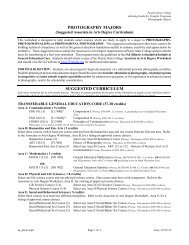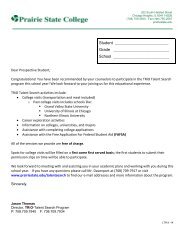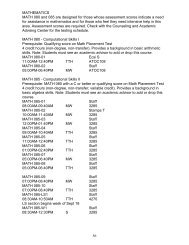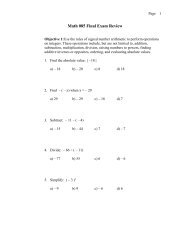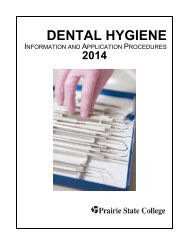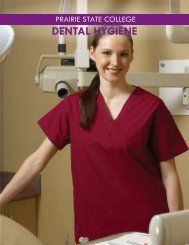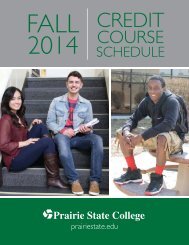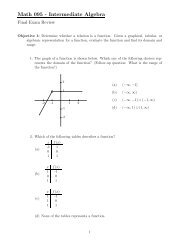catalog - Prairie State College
catalog - Prairie State College
catalog - Prairie State College
- No tags were found...
You also want an ePaper? Increase the reach of your titles
YUMPU automatically turns print PDFs into web optimized ePapers that Google loves.
DEGREES, CERTIFICATES, COURSESTRANSFER DEGREES2006-2008 CATALOGDEGREES,CERTIFICATES,COURSESPRE-ENGINEERINGA.S. Degree • Suggested CurriculumThe engineer is concerned with the application of scientificprinciples to practical problems. Employment opportunities forengineers include the complete spectrum of the workforce andtheoretical research activities. In the typical four-year curriculum,the first two years concentrate on the basic sciencesincluding mathematics, chemistry and physics. The last twoyears emphasize advanced mathematics and science courses.<strong>Prairie</strong> <strong>State</strong> <strong>College</strong> offers courses applicable to the first twoyears of the curriculum and will grant an Associate in Sciencedegree to successful students.I. GENERAL EDUCATION CORE (39-40)Area A: Communication (9 credits)ENG 101 [C1 900] Composition I - with a grade of C or better (3)ENG 102 [C1 901R] Composition II - with a grade of C or better (3)COMM 101 [C2 900] Principles of Communication (3)Area B: Humanities and Fine Arts (9 credits)Select 3 courses from the list for Area B on pages 42-44, with at leastone course from humanities and one course from fine arts.Area C: Mathematics (5 credits)MATH 171 [EGR 901] Calculus with Analytic Geometry I (5)Area D: Physical and Life Sciences (7-8 credits)PHYSI 210 [EGR 911] University Physics I (4)Select one life science course (3-4)Area E: Social and Behavioral Sciences (9 credits)Select 3 courses in at least two different disciplines from list for Area Eon pages 42-44.ECON 201 [S3 901] Macroeconomic Principles (3) recommendedECON 202 [S3 902] Microeconomic Principles (3) recommendedSelect one Social & Behavioral Science Course, other than ECON (3)II. AREA OF CONCENTRATION/MAJOR FIELD (22)Essential Engineering prerequisite courses: Select from the following:CHEM 110 [EGR 961] General Chemistry I (5)MATH 172 [EGR 902] Calculus with Analytic Geometry II (5)MATH 173 [EGR 903] Calculus with Analytic Geometry III (5)MATH 216 [EGR 904] Differential Equations (3)PHYSI 220 [EGR 912] University Physics II (4)III. ELECTIVES (minimum of 0-1)Engineering Speciality Courses For Chemical EngineeringCHEM 130 [EGR 931] General Chemistry II (5)CHEM 203 [EGR 932] Organic Chemistry I (5)CHEM 204 [EGR 933] Organic Chemistry II (5)Engineering Speciality Courses For Civil EngineeringCADMD 245 [EGR 941] Computer Aided Design (3)PHYSI 235 [EGR 942] Statics (3)PHYSI 240 [EGR 943] Dynamics (3)Engineering Speciality Courses For Computer Engineering MajorsPHYSI 230 [EGR 914] University Physics III (4)Engineering Speciality Courses For Electrical Engineering MajorsPHYSI 230 [EGR 914] University Physics III (4)Engineering Speciality Courses For Industrial Engineering MajorsPHYSI 235 [EGR 942] Statics (3)PHYSI 240 [EGR 943] Dynamics (3)Required A.S. Degree Program Total: 62 creditsENGLISH/LITERATUREA.A. Degree • Suggested CurriculumFour-year degree programs in English emphasize study of literatureand literary criticism. Specializations in creative and/ortechnical writing prepare a student for certification as a highschoolEnglish teacher as well as for a wide range of professionalwriting jobs. An English major is considered good preparationfor some professional programs. Students seeking a bachelor’sdegree in English are strongly encouraged to complete an A.A.or A.S. degree prior to transfer. Since all literature coursesrequire substantial formal writing, it is highly recommended thatstudents complete the two-course writing sequence beforeenrolling in literature courses. Students are encouraged to keepcourse syllabi and a personal writing portfolio.I. GENERAL EDUCATION CORE (37-38)Area A: Communication (9 credits)ENG 101 [C1 900] Composition I - with a grade of C or better (3)ENG 102 [C1 901R] Composition II - with a grade of C or better (3)COMM 101 [C2 900] Principles of Communication (3)Area B: Humanities and Fine Arts (9 credits)Select three courses from the list for Area B on pages 42-44, with atleast one course from humanities and one course from fine arts.Area C: Mathematics (3 credits)Select one math course from:MATH 112 [M1 904] General Education Mathematics (3)MATH 115 [M1 902] General Education Statistics (3)Area D: Physical and Life Sciences (7-8 credits)Select one life science course and one physical science course from thelist for Area D on pages 42-44. One course must have a lab component.Area E: Social and Behavioral Sciences (9 credits)Select three courses in at least two different disciplines from the list forArea E on pages 42-44.II.AREA OF CONCENTRATION/MAJOR FIELD (12)Select up to three courses from the following survey courses:ENG 211 [EGL 911] American Literature I (3)ENG 212 [EGL 912] American Literature II (3)ENG 231 [EGL 913] British Literature I (3)ENG 232 [EGL 914] British Literature II (3)In addition to the survey courses, or in place of one of them, select onecourse from the following genre courses:ENG 221 [EGL 915] Introduction to Poetry (3)ENG 240 [EGL 917] Introduction to Fiction (3)ENG 252 [EGL 916] Introduction to Drama (3)III. ELECTIVES (12-13)Some universities require multicultural dimensions within the major.The following courses will fulfill that requirement:ENG 215 [H3 910D] African-American Literature (3)ENG 243 [EGL 919] Non-Western Literature in Translation (3)Universities offering a creative writing specialization will accept thefollowing course in the creative writing specialization only:ENG 110 [EGL 922] Creative Writing: Poetry (3)ENG 111 [EGL 924] Creative Writing: Nonfiction Prose (3)Foreign Language* (4-16)Required A.A. Degree Program Total: 62 creditsForeign Language Requirements: Some universities have a foreign languagerequirement. Generally, four years of a single foreign language in high schoolor four semesters of language in college will fulfill this requirement. It isrecommended that students complete the entire sequence at one institution.56



